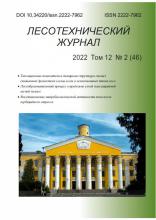Voronezh, Russian Federation
Voronezh, Voronezh, Russian Federation
Voronezh, Voronezh, Russian Federation
Voronezh, Voronezh, Russian Federation
The creation of forest-park green belts is defined by chapter IX.1 of the Federal Law "On Environmental Protection" for the purpose of limiting mode of nature use and management and conservation of natural ecological systems. Forest-park green belts are a new form of realization of the right of urban residents to a favourable environment. In the forest-steppe zone, important bioclimatic and environmental requirements are imposed on the formation of forest-park green belts: in winter – protection from adverse winds; in summer – protection from dust storms, dry winds, from excessive insolation, fastening of slopes, ravines, soils. Forest-park green belts should carry a significant ecosystem load. The most important indicator of the successful functioning of forest-park green belt is its placement, configuration and size. It is scientifically justified to use four criteria for determining priority areas for inclusion in the forest-park green belt. The localization criterion, which is the basis for the inclusion of the site in the forest-park green belt, reflects the remoteness of the site (proximity) from the urban agglomeration. The criterion of "ecosystem load" reflects the fulfilment of the ecological functions by the site. The criterion "Site type" serves to determine the origin of the site and evaluate its distinctive features. The criterion "Existence of encumbrances" serves as an indicator of the incompatibility of the site with the goals of creating a forest-park green belt. The selection of sites for inclusion in the forest-park green belt is carried out taking into account the opinion of experts on the results of their questioning. The proposed methodical approach to identifying sites for inclusion in the forest-park green belt can be used at all levels of forest management by regional executive authorities to justify management decisions to create a "green shield" of the territories.
forest park green belts, ecosystem load, forest management, regional economy, forest management
Климатические изменения и возрастающая антропогенная нагрузка ставят новые экологические вызовы в части загрязнения окружающей среды и ухудшения качества жизни вследствие разрушения лесных экосистем и деградации пригородных лесов в РФ.
Правительство России, осознавая значимость этих проблем, в 2016 году дополнило Федеральный закон «Об охране окружающей среды» главой IX.1, вступившей в силу c 1 января 2017 г., – «Лесопарковые зеленые пояса» [1].
1. Federal'nyj Zakon ot 10.01.2002 № 7-FZ (red. ot 29.07.2017) "Ob ohrane okruzhayushchej sredy". - Available at: http://www.consultant.ru/document/cons_doc_LAW_34823/.
2. Lesnoj plan Voronezhskoj oblasti. - URL: http://ulh.govvrn.ru/Shared Documents/Lesnoy Plan Voronezhskoy oblasti.doc.
3. Pisarenko A. I. Tekhnologiya predvideniya i budushchee lesnogo hozyajstva / A. I. Pisarenko, V. V. Strahov // Lesnoe hozyajstvo. - 2008. - Vol. 6. - P. 2-6. EDN: https://elibrary.ru/JWCQFP
4. Ekonomika sohraneniya bioraznoobraziya / Pod red. A.vA. Tishkova. - M., 2002. - P. 203.
5. Boyd J. What are ecosystem services? [Text] / J. Boyd, S. Banzhaf // Ecological Economics. - 2007. - No. 63 (2-3). - P. 616-626.
6. Chee Y. E. An ecological perspective on the valuation of ecosystem services / Y. E. Chee // Biological Conservation. - 2004. - № 120. - P. 549-565.
7. Daily G. C. Introduction: what are ecosystem services / G. C. Daily // Nature’s Services: Societal Dependence on Natural Ecosystems. - Island Press, Washington DC, 1997. - P. 1-10.
8. The value of the world's ecosystem services and natural capital / R. Costanza [et al.] // Nature 387. - 1997. - P. 253-260.
9. Innovative technology to improve the sustainability of oak forests to pests and diseases in urban environment / A. I. Gorobets, S. S. Morkovina, N. N. Kharchenko, V. V. Posmetyev // Education Excellence and Innovation Management through Vision 2020 From Regional Development Sustainability to Global Economic Growth: Proceedings of the 29th International Business Information Management Association Conference ; ed.: Khalid S. Soliman. - 2017. - P. 2192-2199.
10. Martynyuk A. A. Metody funkcional'no-stoimostnogo analiza v strategicheskom planirovanii razvitiya lesnogo hozyajstva v sovremennyh usloviyah / A. A. Martynyuk, M. K. Rafailov // Lesotekhnicheskij zhurnal. - 2015. - Vol. 1. - P. 264-272.
11. Petrov A. P. Rynochnaya organizaciya lesnogo hozyajstva: opyt zarubezhnyh stran i rossijskih regionov / A. P. Petrov, S. S. Morkovina // Lesotekhnicheskij zhurnal. - 2016. - Vol. 4 (24). - P. 250-258. DOI: https://doi.org/10.12737/23465; EDN: https://elibrary.ru/XHJHIP












